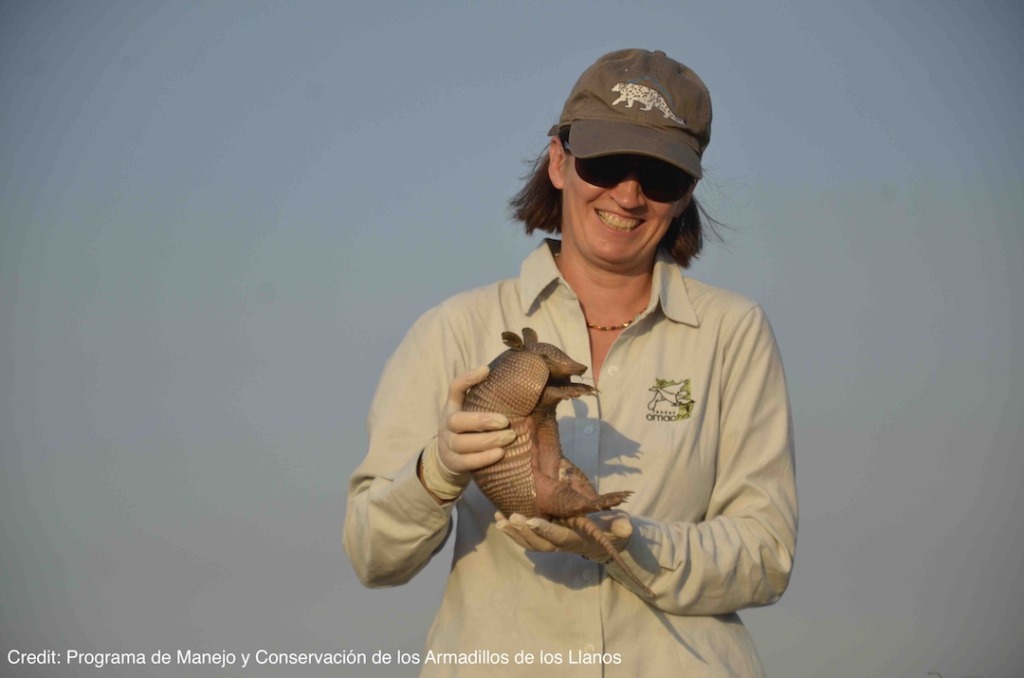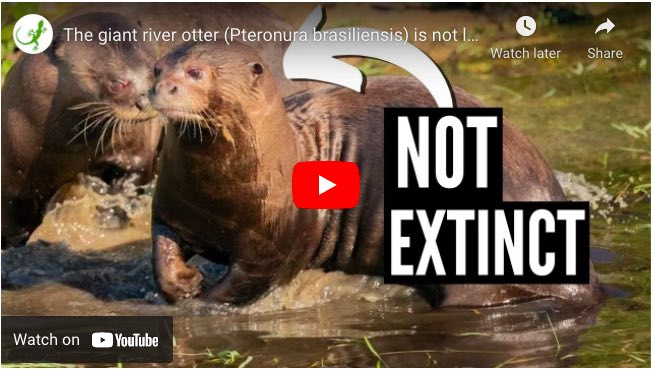Meet the three-banded armadillo:

There are 21 known species of armadillos. The Brazilian three-banded armadillo is endemic to Brazil (it is only found there). This armadillo lives in a dry forest ecosystem in northeastern Brazil called the Caatinga. It also lives in the savannas of the Cerrado, the tropical savanna of eastern Brazil.
The three-banded armadillo has an excellent sense of smell that it uses to hunt ants and termites. When it sniffs out a meal, it uses its sharp claws to excavate the juicy insects and then slurps them up.
In Portuguese, the Brazilian three-banded armadillo is known as the tatu-bola, or the “ball armadillo.” It rolls itself into a complete ball when threatened! This confuses and discourages smaller predators. However its shell offers no protection against jaguars that want to eat it.

Cool!
Individual armadillos have unique scale patterns on their “head shields.”

Three-banded armadillos in trouble
The greatest threat to the three-banded armadillo is overhunting by humans. Rolling itself into a ball can not protect it from people. Hunters simply pick up the ball and sell it for its meat.
For much of the 20th century, scientists thought that the Brazilian three-banded armadillo had been hunted to extinction. However, the species was rediscovered in the late 1980s.
The three-banded armadillo became a celebrity in Brazil and around the world when it was selected as the official mascot of the 2014 FIFA World Cup. Unfortunately, celebrity status did not protect wild armadillos. The number of wild three-banded armadillos is thought to have dropped by 50% since its rediscovery in the 1980s.
A community that cares for its armadillos
However, one community is supporting armadillo conservation and showing how to create a better future for these amazing animals. This is the small community of Sumidouro. Sumidouro is a town of only 200 people in the rugged terrain of Brazil’s Bahia’s state.
Sumidouro is the first place to use citizen science and community-based conservation to protect the Brazilian three-banded armadillo. Citizen science means science conducted by members of the public. (You could be a citizen scientist!) Community-based conservation is when a community works together to conserve its local organisms and ecosystems.
A team of scientists came to Sumidouro to do a biodiversity survey (to understand what animals lived in and around the town). The purpose of the survey was to investigate if creating a wind farm would harm local plants and animals.
As part of the survey, the scientists wanted to monitor the population of armadillos around Sumidouro. The community has played an important part in this work. Local field assistants monitor armadillos in and around agricultural lands and forest fragments. Village residents report armadillo sightings to the project’s database and provide photos and GPS coordinates. This information helps scientists figure out where the armadillo lives around the village.

Good news for the armadillos and the community
The armadillo has become a symbol of local pride in Sumidouro. “We really didn’t have much understanding about the armadillo and its importance before, but we are conscious now of preserving the fauna and flora of the area,” says Claudimiro Souza, president of the association of local rural producers. “We gain so much more by preserving this animal than by killing it. That’s why we’ve embraced the cause and hope it will bring visibility to our community.”
Raising awareness about the value of armadillos is an important part of the conservation effort. Community members participate in biodiversity lectures, workshops, and talk about why armadillos and other wildlife are important. Part of the conservation message is that overhunting of the armadillo could lead to its extinction.
Communities are key to conservation success!
Researchers are beginning to see signs that the armadillo population in Sumidouro is increasing. Not only that, but the armadillo seems to be widespread in the town. This suggests that it is able to survive and live in human-modified environments.
The community-focused approach to conservation in Sumidouro could become a model for protecting the Brazilian three-banded armadillo and other threatened species of the Caatinga, such as the gray brocket deer, the rock cavy, and the northern tigrina.
This story was adapted for Mongabay Kids. It is based on an original article by James Hall, published on Mongabay.com:
You may also like these stories
Admire amazing armadillos with Mariella!

There is such a thing as a fairy armadillo…







